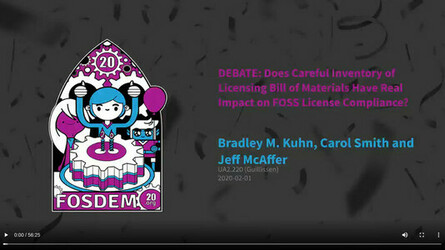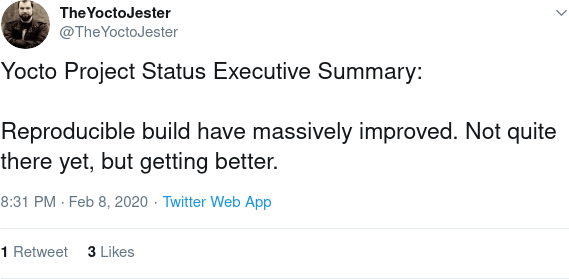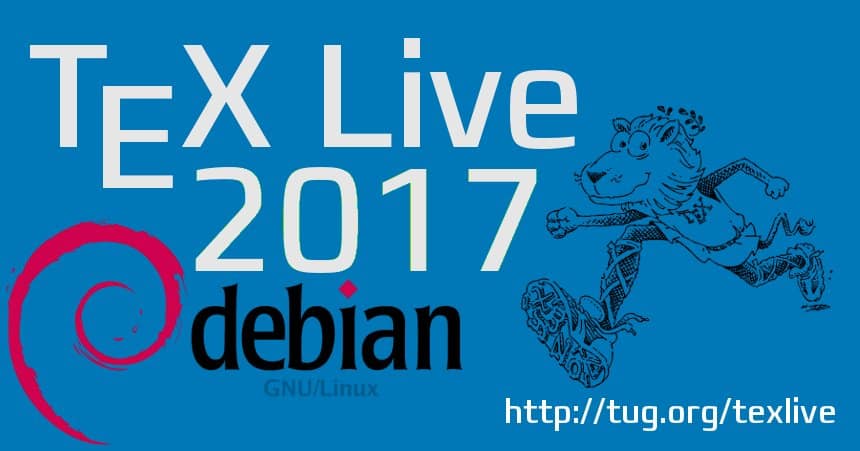Chris Lamb: Free software activities in September 2020
 Here is my monthly update covering what I have been doing in the free software world during September 2020 (previous month):
Here is my monthly update covering what I have been doing in the free software world during September 2020 (previous month):
- Updated my tickle-me-email library (which implements Getting Things Done (GTD)-like behaviours in IMAP inboxes) to support adding 'TODO' entries as read or unread based on a runtime configuration parameter. [...]
- As part of my role of being the assistant Secretary of the Open Source Initiative and a board director of Software in the Public Interest, I attended their respective monthly meetings and participated in various licensing and other discussions occurring on the internet as well as the usual internal discussions, etc. I participated in the OSI's inaugural State of the Source conference and began the 'onboarding' of a new project to SPI.
Reproducible Builds One of the original promises of open source software is that distributed peer review and transparency of process results in enhanced end-user security. However, whilst anyone may inspect the source code of free and open source software for malicious flaws, almost all software today is distributed as pre-compiled binaries. This allows nefarious third-parties to compromise systems by injecting malicious code into ostensibly secure software during the various compilation and distribution processes. The motivation behind the Reproducible Builds effort is to ensure no flaws have been introduced during this compilation process by promising identical results are always generated from a given source, thus allowing multiple third-parties to come to a consensus on whether a build was compromised. The project is proud to be a member project of the Software Freedom Conservancy. Conservancy acts as a corporate umbrella allowing projects to operate as non-profit initiatives without managing their own corporate structure. If you like the work of the Conservancy or the Reproducible Builds project, please consider becoming an official supporter. This month, I:
-
Uploaded a number of Debian packages to close reproducibility issues that I had previously provided patches for, including
cfingerd(#831021),grap(#870573),splint(#924003) &schroot(#902804) - Categorised a huge number of packages and issues in the Reproducible Builds "notes" repository and began work on an auto-classifier script.
-
I also submitted 8 patches to fix specific reproducibility issues within Debian for
check-pgbackrest,cif2cell,evince,haskell-haskell-gi-base,libiio,jhbuild,smartdns&smartlist.
-
Updated the main Reproducible Builds website and documentation:
- Worked with Amateur Radio Digital Communications in order to announce their generous sponsorship of the Reproducible Builds project.
- Drafted, published and publicised August's monthly report.
- Update a few titles and the ordering of some top-level navigation elements. [...]
- Improve the documentation on how to signup to Salsa. [...]
- Add some more links to academic papers. [...]
- Also include the general news in our RSS feed [...] and drop including weekly reports from the RSS feed (they are never shown now that we have over 10 items) [...].
- Update ordering and location of various news and links to tarballs, etc. [...][...][...]
- Kept isdebianreproducibleyet.com up to date. [...]
- Continued collaborative work on a scientific/academic article, hopefully to be published within a few months.
diffoscope I made the following changes to diffoscope, including preparing and uploading versions
159 and 160 to Debian:
-
New features:
- Show "ordering differences" only in
strings(1)output by applying the ordering check to all differences across the codebase. [...]
- Show "ordering differences" only in
-
Bug fixes:
- Mark some PGP tests that they require
pgpdump, and check that the associated binary is actually installed before attempting to run it. (#969753) - Don't raise exceptions when cleaning up after
guestfscleanup failure. [...] - Ensure we check
FALLBACK_FILE_EXTENSION_SUFFIX, otherwise we runpgpdumpagainst all files that are recognised byfile(1)asdata. [...]
- Mark some PGP tests that they require
- Codebase improvements:
-
diffoscope.org website improvements:
- Make the (long) demonstration GIF less prominent. [...]
Debian Lintian For Lintian, the static analysis tool for Debian packages, I uploaded versions
2.93.0, 2.94.0, 2.95.0 & 2.96.0 (not counting uploads to the backports repositories), as well as:
-
Bug fixes:
- Don't emit
odd-mark-in-descriptionfor large numbers such as300,000. (#969528) - Update the expected
Vcs- Browser,Gitlocation of modules and applications maintained by recently-merged Python module/app teams. (#970743) - Relax checks around looking for the
dh(1)sequencer by not looking for the precedingtarget:. (#970920) - Don't try and open
debian/patches/seriesif it does not exist. [...] - Update all
$LINTIAN_VERSIONassignments in scripts and not just the ones we specify; we had added and removed some during development. [...]
- Don't emit
-
Tag updates:
- Clarify which
Vcs-*thevcs-field-not-canonicaltag is being emitted for and update its long description to remove misleading messages. (#970201) - Clarify logic in the long description for
odd-mark-in-description. [...] - Correct a typo in the long description for the
odd-mark-in-descriptiontag. [...]
- Clarify which
-
Developer documentation updates:
- Add prominent and up-to-date information on how to run the testsuite. (#923696)
- Drop recommendation to update
debian/changelogmanually. [...] - Apply
wrap-and-sort -sato thedebiansubdirectory. [...] - Merge
data/READMEintoCONTRIBUTING.mdfor greater visibility [...] and moveCONTRIBUTING.mdto use#-style Markdown headers [...].
-
Investigated and triaged
golang-1.7,inspircd,kleopatra,libdbi-perl,open-build-service,openssl,openssl1.0,python-django.,tinymce,yaws&zeromq3, amongst others. - Frontdesk duties, responding to user/developer questions, reviewing others' packages, attending our monthly IRC meeting, participating in mailing list discussions, etc.
-
Issued DLA 2368-1 for
gruntto fix an arbitrary code execution vulnerability due to the unsafe loading of YAML documents. -
Issued DLA 2370-1 and ELA-281-1 for the
python-pipPython package installer to fix a directory traversal attack where arbitrary local files (eg./root/.ssh/authorized_keys) could be overridden. -
Issued DLA 2372-1 and ELA-282-1 to prevent a denial of service attack in
libproxy, a library to make applications HTTP proxy-aware. -
Issued DLA 2374-1 for the
gnome-shellcomponent of the GNOME desktop. In certain configurations, when logging out of an account, the password box from the login dialog could reappear with the password visible in plaintext. -
Issued DLA 2380-1 for
ruby-gon, a library to send/convert data to Javascript from Ruby applications, to prevent cross-site scripting (XSS) vulnerabilities.

-
python-django (
2.2.16-1&3.1.1-1) New upstream security releases. -
memcached:
1.6.7+dfsg-1New upstream release.1.6.7+dfsg-2&1.6.7+dfsg-3Run tests in single CPU mode. (#968603)
-
redis (
6.0.7-1&6.0.8-1) New upstream releases & miscellaneous packaging updates. -
docbook-to-man (
2.0.0-45) Ensureshunit2autopkgtest dependency is cross-architecture friendly. (#969604)
-
bluez-source: Containsbluez-source-tmpdirectory. (#970130) -
bookworm: Manual page contains debugging/warning/error information from running binary. (#970277) -
jhbuild: Missing runtime dependency onpython3-distutils. (#971418) -
wxwidgets3.0: Links in documentation points to within the original build path, not the installed path. (#970431)
 Some people believe that automatic contact tracing apps will
help contain the Coronavirus epidemic. They won t.
Sorry to bring the bad news, but IT and mobile phones and artificial
intelligence will not solve every problem.
In my opinion, those that promise to solve these things with
artificial intelligence / mobile phones / apps / your-favorite-buzzword
are at least overly optimistic and blinder Aktionismus (*),
if not naive, detachted from reality,
or fraudsters that just want to get some funding.
(*) there does not seem to be an English word for this doing something
just for the sake of doing something, without thinking about whether it makes sense to do so
Here are the reasons why it will not work:
Some people believe that automatic contact tracing apps will
help contain the Coronavirus epidemic. They won t.
Sorry to bring the bad news, but IT and mobile phones and artificial
intelligence will not solve every problem.
In my opinion, those that promise to solve these things with
artificial intelligence / mobile phones / apps / your-favorite-buzzword
are at least overly optimistic and blinder Aktionismus (*),
if not naive, detachted from reality,
or fraudsters that just want to get some funding.
(*) there does not seem to be an English word for this doing something
just for the sake of doing something, without thinking about whether it makes sense to do so
Here are the reasons why it will not work:
 Because
Because  There have been lot of stories about Coronavirus and with it a lot of political blame-game has been happening. The first step that India took of a lockdown is and was a good step but without having a plan as to how especially the poor and the needy and especially the huge migrant population that India has (internal migration) be affected by it. A 2019 World Economic Forum
There have been lot of stories about Coronavirus and with it a lot of political blame-game has been happening. The first step that India took of a lockdown is and was a good step but without having a plan as to how especially the poor and the needy and especially the huge migrant population that India has (internal migration) be affected by it. A 2019 World Economic Forum 










](http://jmtd.net/log/coil/400x-coil.jpg)
 This post has it all. Flotillas of sailboats, peer-to-peer wikis, games,
and de-frogging. But, I need to start by talking about some tech you may not
have heard of yet...
This post has it all. Flotillas of sailboats, peer-to-peer wikis, games,
and de-frogging. But, I need to start by talking about some tech you may not
have heard of yet...
 and filesystem changes (!!). En vrac, a list of
changes which may be of interest:
and filesystem changes (!!). En vrac, a list of
changes which may be of interest:
 Debconf17 has come and gone by too fast, so we all could use a moment looing back at all the fun and serious happenings of the main event in the Debian social calendar. You can find my full photo gallery on
Debconf17 has come and gone by too fast, so we all could use a moment looing back at all the fun and serious happenings of the main event in the Debian social calendar. You can find my full photo gallery on  Yesterday I uploaded the first packages of
Yesterday I uploaded the first packages of  I mentioned already in a
I mentioned already in a 



